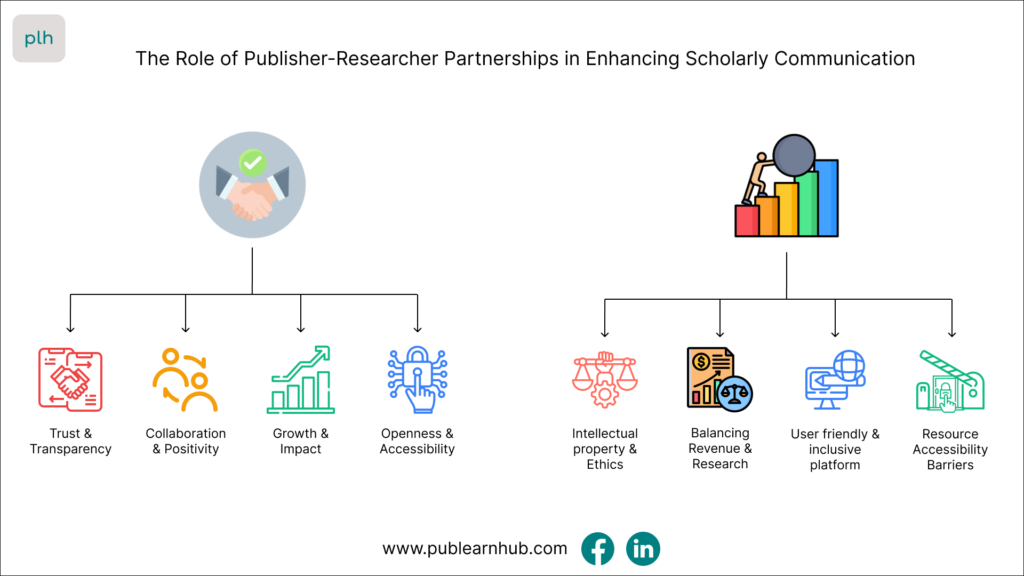The Role of Publisher-Researcher Partnerships in Enhancing Scholarly Communication
Reading time - 2 to 3 minutes
Introduction
The relationship between publishers and researchers has evolved significantly in recent years. No longer just transactional, these partnerships now focus on collaboration and mutual benefit, playing a crucial role in enhancing scholarly communication. As research becomes more complex and globalized, the collaboration between publishers and researchers is critical in improving the accessibility, dissemination, and impact of scholarly work. This article will explore how these partnerships are reshaping the future of academic publishing.
How Publisher-Researcher Partnerships Benefit Scholarly Communication
Publishers and researchers have distinct roles in the academic ecosystem. Publishers are responsible for disseminating research to a broader audience, while researchers create the knowledge that drives innovation. However, these roles are becoming more intertwined as the demand for accessible, high-quality research increases. Collaborative partnerships between publishers and researchers help bridge the gap between research creation and dissemination.
- Improving Accessibility of Research
One of the most significant benefits of publisher-researcher partnerships is the improvement of research accessibility. Publishers and researchers are working together to ensure that academic research is available to a global audience. Through initiatives like open access publishing, research is no longer confined behind paywalls. Platforms such as PLOS ONE and DOAJ are examples of open access models where publishers collaborate with researchers to make their findings freely available.
Open access models not only enhance the visibility of research but also enable faster dissemination, reaching a broader audience, including policymakers, practitioners, and the general public. These collaborations are vital for making research available to those who might not otherwise have access to expensive journal subscriptions, especially in low- and middle-income countries.
- Enhancing the Reach and Impact of Research
Publisher-researcher partnerships help to amplify the impact of academic research by ensuring that it reaches the right audience. By working with publishers, researchers can leverage established distribution networks, marketing tools, and visibility strategies that increase the likelihood of their work being read and cited. Additionally, publishers often provide value-added services such as professional editing, formatting, and indexing, which improve the quality and presentation of research, making it more accessible and understandable to a wider audience.
Research platforms like SpringerLink and JSTOR serve as examples of partnerships that enhance the discoverability of academic content. These platforms aggregate research from multiple disciplines and help increase the likelihood that studies will be noticed and referenced by other scholars, which leads to greater scholarly impact.
- Fostering Collaborative Research
Publisher-researcher partnerships also facilitate collaboration between scholars. Many publishers now offer platforms for researchers to connect, share ideas, and work on joint projects. For instance, publishers like Elsevier and Wiley offer collaborative tools that allow researchers to share data, co-author articles, and engage in peer review, helping to promote interdisciplinary research and innovation.
These platforms also allow researchers to find potential collaborators in their field, which encourages the sharing of expertise and ideas, driving innovation in academic research.
- Supporting Data Sharing and Transparency
In addition to publishing articles, researchers and publishers are collaborating to improve the transparency and sharing of research data. Publishers are increasingly supporting data repositories like Zenodo and Dryad, where researchers can store and share their raw data sets, ensuring that research findings are verifiable and reproducible.
By encouraging data sharing, publishers help foster a culture of openness and transparency in research, which is critical for scientific progress. These collaborations also ensure that the research process remains accountable and trustworthy, allowing others to verify, replicate, and build upon existing findings.
Challenges in Publisher-Researcher Partnerships
While these partnerships offer numerous benefits, they also come with challenges. Publishers and researchers must navigate issues related to intellectual property rights, funding, and ethical considerations. Balancing the interests of publishers, who need to generate revenue, and researchers, who seek to disseminate their findings as widely as possible, can be a delicate task.
Additionally, ensuring that collaborative platforms are user-friendly, inclusive, and equitable remains a priority for both researchers and publishers. The goal is to foster collaboration without creating barriers for those who may lack the resources to access premium services or tools.
Conclusion
Publisher-researcher partnerships are transforming scholarly communication, offering more accessible, timely, and impactful research dissemination. By collaborating on open access initiatives, increasing the reach of research, fostering interdisciplinary collaboration, and supporting data transparency, these partnerships are helping to shape the future of academic publishing. As research continues to evolve, these partnerships will remain essential for advancing knowledge, promoting innovation, and ensuring that the academic community remains connected and engaged.
